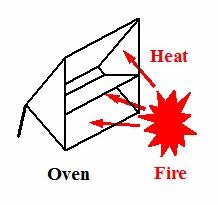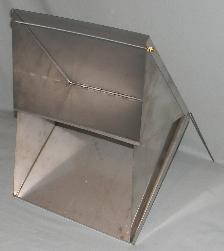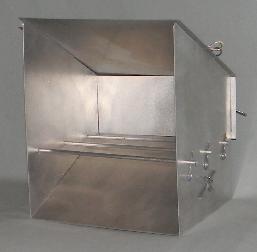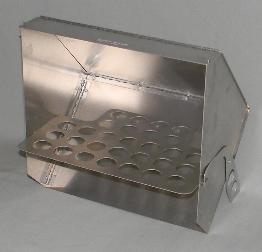

































 A reflector oven is usually made of aluminum, or metal, or stainless steel. It is placed about 8 inches away from a wood fire and the heat from the fire enters the front of the oven and the heat bakes the food that is put on the center shelf of the oven.
A reflector oven is usually made of aluminum, or metal, or stainless steel. It is placed about 8 inches away from a wood fire and the heat from the fire enters the front of the oven and the heat bakes the food that is put on the center shelf of the oven. Fire Temperature: The temperature of a fire depends on a variety of factors, such as: the type of wood being burned, how dry the wood is, the diameter of the fire on the ground, the height of the firewood inside the fire, the amount of air circulating around the fire, and how long the fire has been burning. You can place a standard oven thermometer on the center shelf of the reflector oven to determine approximately how hot the fire is at different distances from the fire. Remove the oven thermometer before you put the food in the oven.
Fire Temperature: The temperature of a fire depends on a variety of factors, such as: the type of wood being burned, how dry the wood is, the diameter of the fire on the ground, the height of the firewood inside the fire, the amount of air circulating around the fire, and how long the fire has been burning. You can place a standard oven thermometer on the center shelf of the reflector oven to determine approximately how hot the fire is at different distances from the fire. Remove the oven thermometer before you put the food in the oven. |
 |
 |
 |
| Wiseman: Price $73.94 Material: Stainless Steel Weight: 108 ounces (6.75 pounds) Flat: 13.25" x 13.5" x 0.75" Assembled: H 18.75" x L 13.5" x D 9.5" Max Bake Pan: H 2.5" x L 13" x D 6.75" Available: See Link Below |
Old Scout: Price $75.00 Material: Aluminum Weight: 24 ounces (1.5 pounds) Flat: 12" x 10.5" x 0.5" Assembled: H 12" x L 10.25" x D 9.75" Max Bake Pan: H 4" x L 9.5" x D 9.5" Available: See Link Below |
Reflecto: Price $95.48 Material: Aluminum Weight: 21.5 ounces (1.34 pounds) Flat: 7.75" x 10.5" x 0.5" Assembled: H 10.75" x L 10.5" x D 8.75" Max Bake Pan: H 2.25" x L 10.25" x D 6" Available on Amazon |
Sproul: Price $181.99 Material: Tinned Steel Weight: 36 ounces (2.25 pounds) Flat: 13" x 13.25" x 2.5" Assembled: H 11.5" x L 13.5" x D 7.75" Max Bake Pan: H 2.75" x L 13" x D 7.5" Available on Amazon |

